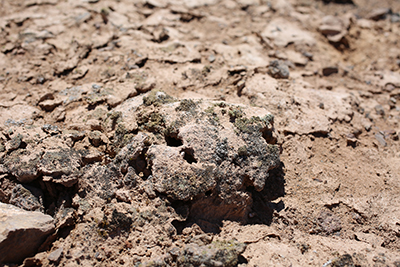Source: Journal of Geophysical Research: Biogeosciences
Robots like Viking, Phoenix, and Curiosity have found indirect evidence of oxalate minerals on Mars. New techniques tested in the Chile’s Atacama Desert could help future Mars rovers analyze these minerals for possible by-products of life.
Organic oxalates tie up carbon, creating carbon sinks that are extremely resistant to most physical and chemical weathering. On Earth, oxalates are primarily broken down by biological weathering; fungus and bacteria consume oxalate, recycling carbon back into the environment. But Mars’s carbon cycle is not as well understood. Developing better techniques to identify trace concentrations of oxalates may provide insights into the processes at play on the Red Planet.

In a new paper, Cheng et al. used samples from a terrestrial analogue of Mars—the Salar Grande basin in the Atacama Desert—to test out various techniques for detecting and characterizing oxalate-bearing rocks. They found that although X-ray diffraction could detect insoluble oxalate concentrates of approximately 2%–4% or higher, only ion chromatography could detect lower concentrations of soluble oxalates.
The team specifically tuned their instruments to search for weddellite and whewellite oxalate minerals formed by biological activity. They found concentrations of weddellite and whewellite in samples collected in the sediment record infilling the Salar Grande basin, which demonstrates the great preservation potential for oxalate compounds sourced in biological activity. This suggests that any similar oxalate-bearing deposits on Mars are worth closer investigation in the ongoing search for life.
Oxalate minerals can be formed by meteoritic, primordial, geothermal, and biological processes and so are not inherently indicators of life, but their resistance to most forms of nonbiological weathering make them a noteworthy aspect of the carbon cycle. Future research could use the techniques tested in Chile for more sensitive detection of oxalates on Mars. This in turn could lead to insights into Martian carbon sinks and sources. (Journal of Geophysical Research: Biogeosciences, doi:10.1002/2016JG003439, 2016)
—Mika McKinnon, Freelance Writer
Citation:
McKinnon, M. (2016), Rocks in Chile help scientists hunt for life on Mars, Eos, 97, https://doi.org/10.1029/2016EO057363. Published on 09 August 2016.
Text © 2016. The authors. CC BY-NC-ND 3.0
Except where otherwise noted, images are subject to copyright. Any reuse without express permission from the copyright owner is prohibited.

